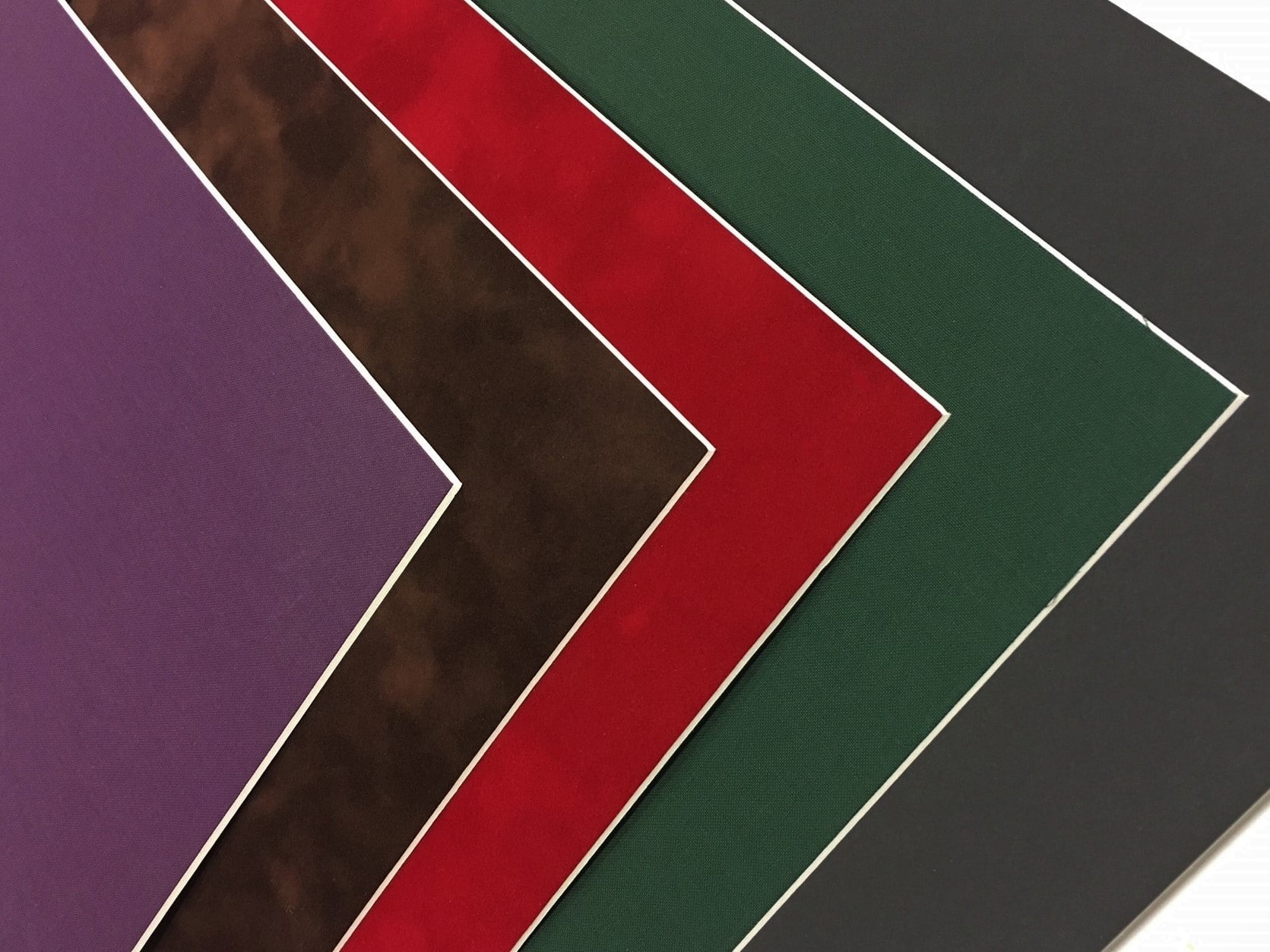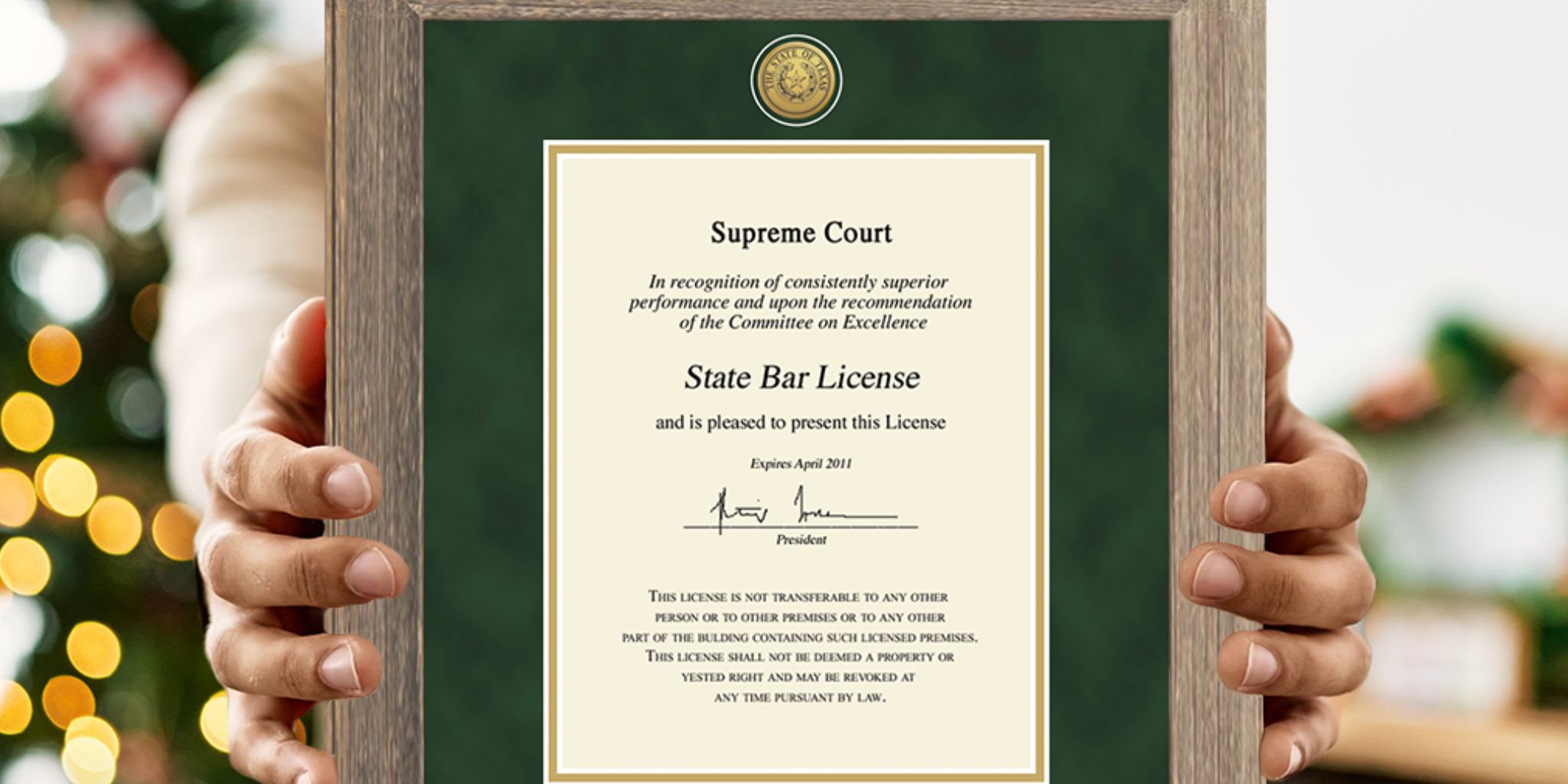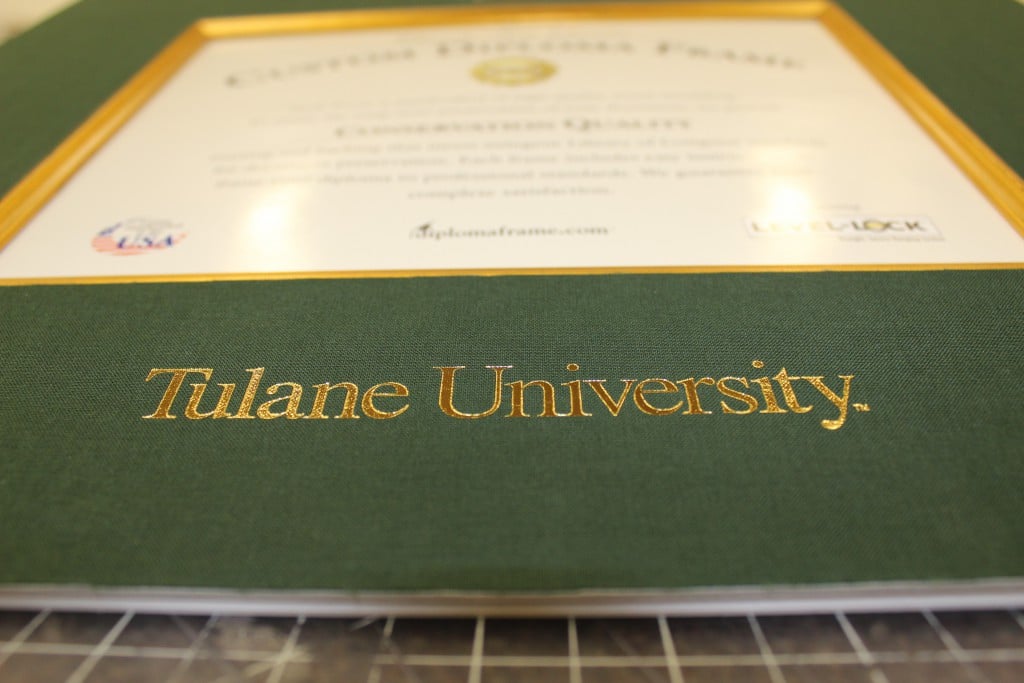
Framing and matting a document or piece of art is important. We must consider the value and purpose of the object being displayed. This will help us create a display that enhances the object’s beauty. Is the piece is going to be purely decorative, like a painting or mixed media collage? Is it a formal black-and-white wedding photograph from your wedding? Or perhaps it’s a law degree or professional award. Choosing the right frame matting can make all the difference in your display.
For decorative framing, there are many matting and moulding options available to give your piece that special touch. Some decorative options include textured mats, such as suede or linen. You may wish to use double bevel-cut mats or gold or silver fillets for accents. The color combinations you choose can elevate or diminish the finished look. That’s why choosing the right frame mat board is key to creating a cohesive decor element.
What We Use
Your documents are valuable and should be protected. High-end materials will keep your work safe and well-preserved for years to come. Our premium frames carry the “Museum Quality” seal. This is your assurance that museum-grade matting, backing, and mounting materials are used. It’s a guarantee that your mats are lignin-free. All of our custom-cut mats have a pure white bevel that will not discolor over time.

Why Your Frame Mat Choice Is Important
Choosing the right mat and frame color, type, and quality is important to preserving the look of your art. It’s important to note that while many matting options are aesthetically pleasing, they may not be up to conservation standards. As a result, they could end up damaging your piece in the long run.
When selecting a mat, you must consider the value and importance of the piece to be framed. Use this information to guide your matting choice.
To preserve your print and frame for many years to come, choose your mounting board carefully. Begin by finding out if your mat choice meets the U.S. Congress fine art trade guild stringent standards. This means that it’s acid-free, lignin-free, and is inherently neutral, not merely buffered to a neutral pH level. Luckily, the archival mat boards we use for each frame are conservation-quality and will protect your valuable document. We have a Professional Picture Framers Association member on staff and comply with the art trade guild PPFA guidelines.
The two major effects of using non-conservation pre-cut mats include acid mat burn and discoloration. Acid mat burn can damage artwork or documents. It causes yellowish-brown stains around the edges of the paper where it touches the mat. If an acidic backing is also used, these stains will spread over the entire paper.
Mat burn will not only cause yellowing but will also make the paper brittle and weak. That means your work of art can tear easily, leaving it open to further damage. It’s why fade- and bleed-resistant mats are critical.
Of course, discoloration is not always caused by acid mat burn. Certain mat types do not meet the Library of Congress fine and highest levels of quality standards. As a result, colors will bleed through the mat onto the paper. Leather mats, for example, seem to be a high-end choice; however, they are not archival-quality. Over time, a leather mat can cause acid burn damage. Plus, the colorant in the leather mat is subject to bleeding. This can create streaks in the artwork or document being framed.
When it comes to custom framing, Church Hill Classics only uses ragmat museum matboard. That’s because cotton rag mat board for framing is top-notch quality. Our suede, linen, and traditional mats all meet the high standards of the Library of Congress.

Types of Mat Board
A decorative mat board is made simply from paper and is not conservation-quality. The back is buffered with calcium carbonate to make it non-acidic. However, non-acidic does not mean the same thing as acid-free. Over time, the mat board will return to its original state and can damage the artwork.
Non-acidic is the least expensive and provides the greatest variety of colors and textures. However, it cannot be overstated: This is material should never be used. It will ruin documents that hold significant monetary and personal value.
Archival Mat Boards
There are two types of conservation-quality mat board, rag and alpha-cellulose. The only type of naturally acid-free mat board is rag mat board, which is made from cotton. One benefit of rag mat board is that it’s natural, environmentally friendly, and easily renewable.
Standard rag mat board is made with a 100% cotton core and backing. And it has an acid-free, bleed-resistant colored facing paper. It’s more expensive than plain decorative mats. However, there are several color and texture mat options to choose from, such as suede mat board and linen.
Standard rag mat board is recommended when framing fine art prints, photos, and valuable documents. When framing rare, historical, or antique artwork or documents, many conservators choose 100% rag mat board. This means the face, core, and backing are all cotton and a single color. Typically, it’s a white or neutral hue on the surface and all the way through.
The second conservation matting option is alpha-cellulose mat board, which is produced using virgin alpha-cellulose purified wood pulp. Virgin alpha-cellulose has been treated. This treatment eliminates acids and lignins which can degrade mat board and artwork. The face color on this type of board is created with bleed-resistant organic pigments. And the mats are available in more than 300 hues.
Research has shown that alpha-cellulose boards with MicroChamber technology and zeolite can reduce the effects of pollutants. This includes acidic gasses such as sulfur dioxide and nitrogen. Over time, the pollutants can be effectively reduced.
Our mat boards proactively trap and neutralize pollutants and acid that can damage artwork. Alpha-cellulose mat boards are appropriate for framing valuable art, important or historical documents, and photos or collectibles.

How to Choose Mat and Frame for Art
Once you determine the type of frame matting for your art, many of the other details are up to personal choice. If you are framing a black-and-white photo, consider choosing a color that makes it stand out. This will help the photograph draw more attention. You may even wish to add use a contrasting accent mat. On the other hand, you could go with a white core for a more cohesive, classic look.
You’ll also want to consider the thickness of your mat. You can choose from a single mat or double thickness depending on how you want your art to look and feel. You may also need to invest in a thicker mat depending on the weight of your art.
From there, you can find the perfect frame for your masterpiece. If nothing catches your eye or is making your colored mat, consider custom framing. This is one of the best ways to get a high-quality frame that meets your needs and personal style.
What We Use
Your documents are valuable and should be protected. High-end materials will keep your work safe and well-preserved for years to come. Our premium frames carry the “Museum Quality” seal. This is your assurance that museum-grade matting, backing, and mounting materials are used. It’s a guarantee that your mats are lignin-free. All of our custom-cut mats have a pure white bevel that will not discolor over time.

Lucie Voves
Lucie Voves is the Founder and CEO of Church Hill Classics/diplomaframe.com, a certified woman-owned business and 12-time Inc. 5000 Award Honoree.









